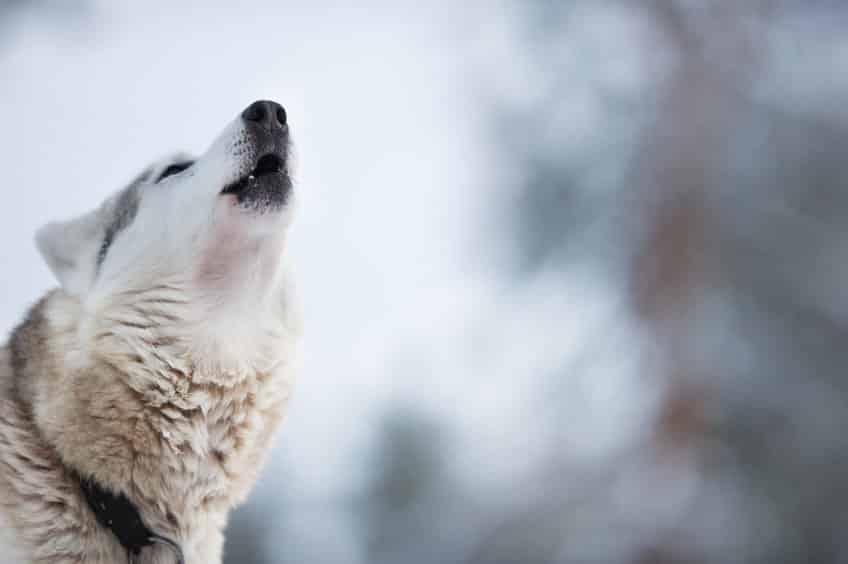By Jessica Scarpati –
For any dog lover who watched Game of Thrones, it was hard not to be wowed by the majesty of the Stark family’s mythical direwolves. Admittedly, while their on-screen size was digitally enhanced, their lupine looks were not. Ironically, the real-life pups who played Ghost, Nymeria and the rest of the direwolf pack weren’t wolves at all. They were a domestic breed called Northern Inuit dogs. Still, that didn’t stop a surge of interest in wolfdogs—hybrid animals that are part wolf and part dog.
That popularity continues today, thanks to social media, with accounts like Loki the Wolfdog garnering 2 million followers on Instagram. (As a point of comparison, Martha Stewart has 1.4 million followers.)
Created through selective breeding, wolfdogs (also known as wolf-dog hybrids) are most commonly created by mating a gray wolf with an Alaskan malamute, husky, poodle or German shepherd, explains veterinarian Dr. Debora Lichtenberg on Petful.com.
All of this sounds great to dog lovers looking for something different. That’s understandable considering the emotional and physical benefits dogs can bring to their owners. But bringing one of these hybrids home and trying to acclimate it to a domestic situation is tricky at best. Beyond stunning looks, wolfdogs may not deliver the companionship benefits of your standard pooch.
Lichtenberg laid out the roll-of-the-dice risk of owning a breed generated by such unique mixes.
“The result may be an animal that acts like a couch potato or a wild animal, but the amount of wolf versus dog genes cannot predict behavior,” he said.
Wolfdog puppies—which can fetch as much as $5,000 by some estimates—are often marketed by the number of generations they are removed from their wolf origins.
The call of the wild has led to approximately 250,000 to 500,000 wolves and wolfdogs living in captivity in the U.S. today, according to the nonprofit Mission: Wolf. Federally, wolfdogs are classified as domestic pets, although individual states and local municipalities have taken steps to outlaw them, especially in the wake of attacks and other incidents.
Although experts say the allure of wolfdogs is understandable, the reality is that few people are as prepared for ownership as they believe themselves to be.
“These are beautiful animals, and a lot of people are attracted to something that’s exotic and different,” wolfdog expert Nicole Wilde, author of Wolfdogs: A–Z, said in an interview with The Bark. “They want to own a piece of the wild, and they often say that the wolf is their spiritual sign or totem animal. Unfortunately, they don’t realize that it’s not really the same thing as having a wolf in their living room.”
The unpredictability of wolfdogs’ behavior stems largely from the drastic differences between wolves and domestic dogs. Despite sharing common ancestry, they otherwise bear little resemblance to each other when it comes to temperament. In other words, don’t expect “fetch” and “roll over” to be part of a wolfdog’s vocabulary.
“Think about wolves, who have territories of 800 square miles and run at 35 or 40 miles an hour,” canine behavior specialist Nicole Wilde told The Atlantic. “A 15-minute potty walk? That’s not going to cut it. Even with the northern [dog] breeds, huskies in particular, people have no idea how much exercise they need.”
Another point to consider: Many veterinarians won’t care for wolfdogs, and the U.S. Food and Drug Administration has not approved the use of the rabies vaccines in so-called hybrid breeds. That means any wolfdog that bites someone must be euthanized due to its rabies risk, The Bark explains.
Behavior is another ruff area. Wolves reach sexual maturity between ages 1 and 4, which is when they begin testing pack leaders for dominance, explains the International Wolf Center. In comparison, dogs mature at around 6 to 8 months, and their instinct to challenge the leader is less intense, according to the global nonprofit. Domesticated dogs have also been selectively bred over thousands of years for specific behavior traits that make them dependent on and eager to please humans, whereas wolves are often shy and don’t have any innate affection toward people.
The resulting clash, rather than blend, of traits often leaves wolfdog owners howling with regret, Alyx Harris, operations manager of the Yamnuska Wolfdog Sanctuary in Canada said in an interview with CBC News.
“You don’t get the best of both worlds. You get the worst of both worlds,” said Harris, whose sanctuary cares for wolfdogs that overwhelmed owners have surrendered. “You’re getting an animal that doesn’t really care to please you, so they’re terrible hunting dogs. They’re terrible guard dogs. They’re fearful of humans. But they really are beautiful.”
That beauty continues to earn wolfdogs loyal fans, and indeed there are enthusiasts who seek to promote responsible ownership and set expectations about what these animals need to thrive.
However, experts caution that simply isn’t possible for most people, even those skilled at working with dogs.
“Many people interested in buying a wolf-dog hybrid are not qualified to train and house them,” Lichtenberg said on Petful.com. “This is no surprise to me. I’ve had many clients, even great dog people, who became overwhelmed by a difficult Beagle or an obnoxious Bichon, not to mention the challenges imposed by more classically difficult dog breeds such as Akitas, some of the Northern breeds and guard dogs whose instincts are closer to the call of the wild.”








